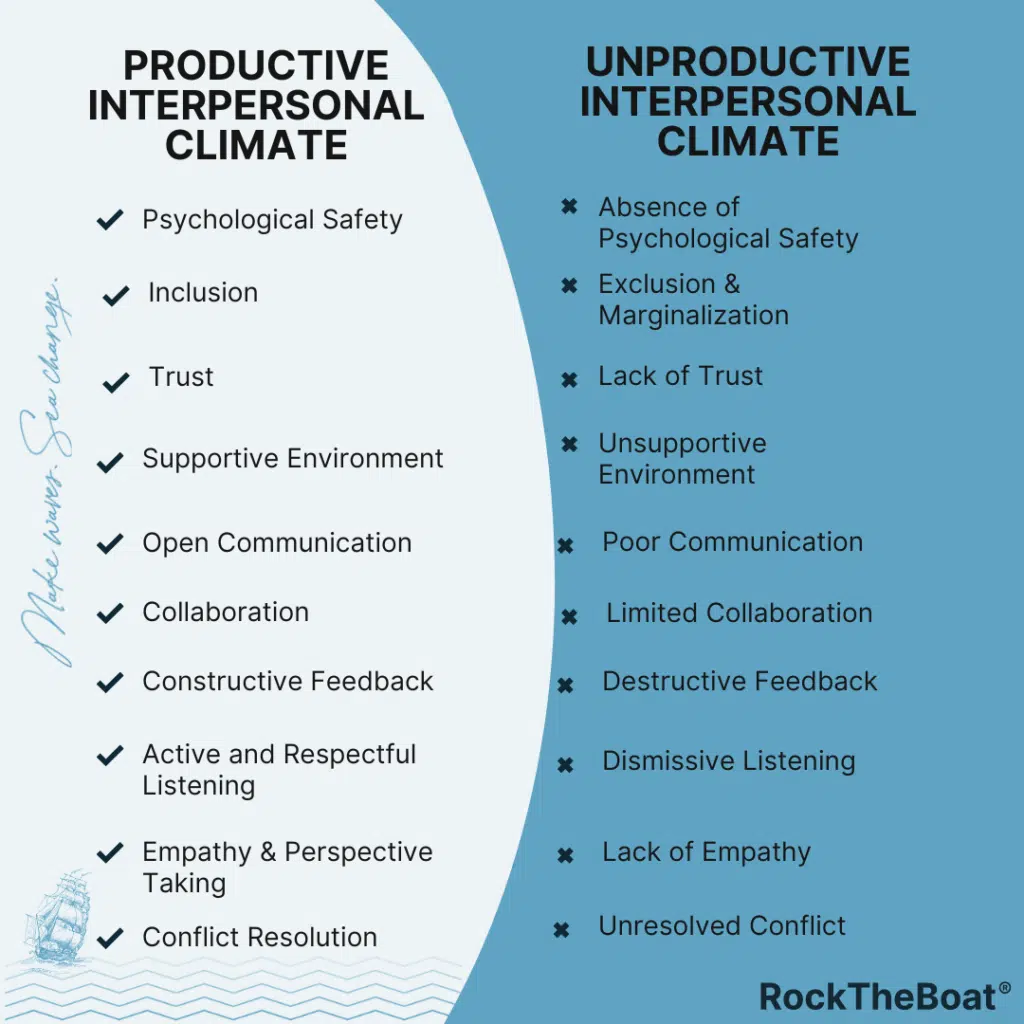Unexpected Consequences of Interpersonal Climate on Teams
Interpersonal climate matters and can make or break team dynamics. On the one hand, building a positive interpersonal climate is vital for creating a team environment that fosters trust, safety, openness, and collaboration. On the other hand, an adverse interpersonal climate can lead to stress, conflict, disengagement, and employee turnover. In this blog, we will explore the unexpected consequences of an interpersonal environment on teams. Plus, highlight the characteristics of productive and unproductive interpersonal climate in groups and team dynamics.
What is the Interpersonal Climate in Your Organization?
- Are mistakes embraced as learning opportunities in this team?
- Does your team promote open and constructive discussions?
- Do you invite divergent perspectives?
- Do team members feel safe taking interpersonal risks?
- Are team members approachable and supportive when seeking help?
- Do team members value and appreciate each other’s contributions?
- How do people work together?
- How do decisions get made?
- What permissions are in place? Experiment? Fail?
- Is learning part of your work climate?
- Are employees engaged, anxious, apathetic, or comfortable?
- Are organizational values tied to daily work?
- How do you acknowledge, recognize, and reward employees?
- What is unique and valuable about working for your organization?
Differences between Productive and Unproductive Interpersonal Climate in the Workplace
Simon Sinek is a renowned author, motivational speaker, and leadership expert. He said, “The quality of the interpersonal climate within a team is the lifeblood of psychological safety. It is the foundation upon which trust, collaboration, and innovation thrive. When team members feel valued, respected, and supported, they are empowered to bring their best selves to the table, contributing to a culture of psychological safety that fuels extraordinary results.”
Improving Psychological Safety: How Relationships, Communication, and Culture Make a Difference
Role of Social Cognition/Thinking
Warmth and competence are two components that influence our decision to trust someone, according to Fiske, Cuddy, and Glick (2007).
Warmth is critical as it signals someone is friendly and kind.
Competence helps us determine if someone is capable and skilled.
We can build trust and develop positive relationships with coworkers by conveying warmth and competence.
Impact of Quality Relationships
Given the average person spends approximately 90,000 hours at work over their lifetime, based on a typical 40-hour workweek and a retirement age of 65, the quality of workplace relationships matters. Positive social interactions can promote brain growth and development, improving overall well-being.
How are the quality of your workplace relationships?
Communication Styles and Effect
Everyone has a communication style, some more effective than others. The types include passive, passive-aggressive, assertive, aggressive, and manipulative.
Passive: You avoid saying what you want, think, or feel.
For example, You remain silent and don’t express your thoughts and feelings.
Passive-Aggressive: You avoid saying what you want, think, or feel but express it indirectly through subtle actions and behaviors.
For example, You make snide remarks or use sarcasm instead of being direct, upfront, and honest.
Assertive: You say what you honestly want, think, and feel in direct and helpful ways.
For example, you express your thoughts, feelings, and needs clearly and respectfully.
Aggressiveness: You say what you want, think, and feel, but at the expense of others.
For example, Your tone of voice is loud or forceful, and body language is threatening, without considering the feelings or opinions of others.
Manipulation: You attempt to control or influence others to meet an objective, irrespective of someone’s feelings or needs.
For example, You use ineffective tactics like guilt-tripping, dishonesty, or messing with someone’s emotions to satisfy your needs.
Importance of Social Signaling
Nonverbal cues, such as facial expressions, body language, and tone of voice, play a significant role in how we perceive others during first impressions. Observing and paying attention to social signals, we can discern between sincere and insincere emotions, friendliness, distance, and awkwardness or ease. Therefore, it’s critical to be mindful of our nonverbal communication to build positive social interactions.
What do you notice regarding others’ social signaling on your team?
How might others describe your social signals in the workplace?
Influence of Power Dynamics
Workplace power dynamics can have positive or negative implications for the interpersonal climate.
How do power dynamics play out in your workplace?
A command and control, dominating top-down approach can lead to employee demoralization, disengagement, and decreased morale.
However, creating a psychologically safe work environment can improve the interpersonal climate.
How are you making psychological safety a core business strategy in your organization?
Cultural Norms and Impact
Create a climate of interpersonal trust whereby people can be comfortable being themselves. Key elements include safety, trust, supportiveness, and mutual respect.
Norms influence the impact of interpersonal climate. A culture of speaking up, challenging the status quo, rocking the boat, and being proactive can lead to a positive interpersonal climate.
A culture of silence, communication silos, fear of humiliation, blame culture, mistrust, micromanagement, lack of transparency, and ineffective leadership can lead to an adverse interpersonal climate.
Culture of Coaching and Growth Mindset
A coaching culture prioritizes personal and professional growth, ongoing learning, and development.
A workplace climate of a growth mindset fosters curiosity, experimentation (take risks and learn from mistakes), and embracing challenges and failures as opportunities for growth versus problems.
Leaders act as coaches by asking open-ended, curious, and powerful questions and regularly providing feedback, guidance, and support to employees to establish and achieve SMART (specific, measurable & meaningful, attainable, realistic, time-bound) goals.
Conclusion
In summary, a positive interpersonal climate can create a sense of ease and comfort in team dynamics. A positive interpersonal climate fosters trust, collaboration, and engagement within a team. Understanding and addressing social signaling, social thinking, meaningful relationships, communication styles, power dynamics, cultural norms, and a coaching culture can improve psychological safety.
Reflections
What is your communication style?
Where do you typically land?
How do members of your team communicate?
How do leaders communicate in your organization?
The goal is to communicate effectively by expressing your thoughts, feelings, and needs directly, respectfully, clearly, and straightforwardly. This promotes a positive interpersonal climate amongst your team.
What is the climate of your organization?
Suppose your organization encounters choppy waters and stormy weather often. In that case, it can make for a tumultuous and uncomfortable experience on a boat, much like an adverse interpersonal climate leading to workplace conflict and discomfort. Rock the Boat can help you not sink your team.
Recent Posts:
Building a Strong Crew: Navigating Conflict in Teamwork
3-Step Approach for Building Psychological Safety and Trust
Recommended Reading
Relational Climate in the Workplace- Dimensions, Measurement, and Validation
Watch TedTalk
Your body language may shape who you are
Meet Jodie, your Culture & Transformation Captain. With over twenty years helping people change, facilitating team discussions, building cultures, designing, implementing and teaching classes, your organization is in good hands.



